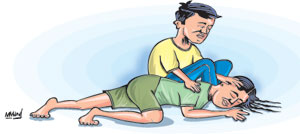A seizure, or as it is commonly known, a fit, is a frightening episode to witness and this is even more so when seen for the first time. A generalised fit may manifest as vigorous movements in the limbs followed by loss of consciousness.
A non-convulsive seizure may be more subtle. We must remember that the person experiencing it is in a vulnerable position and hence it is the responsibility of those around to make sure he or she does not suffer any injury.
 |
| It is best to move the patient onto their side when on the floor, to prevent them from choking on their saliva or vomit. |
A seizure is caused by uncontrolled firing of electrical impulses between cells in the brain. Sometimes there is a reason for them to occur, such as an abnormal or damaged part of the brain e.g. tumours, strokes, abnormal blood vessels. On other occasions there isn't a straightforward reason and it is thought to come about by 'disorganised wiring' of the brain.
There are different types and multiple classification systems to describe seizures. There are multiple investigations which are also carried out to reach a diagnosis, but in this article we look at the first aid aspect involved.
Do’s
- Don't panic! Stay calm.
A fit generally lasts only for a short period of time. Remember the person having the fit may not hear you
- Protect from injury
If the person is at a height, move him to the floor, remove sharp objects, hot fluids and anything else that can hurt him from within reach
- Sometimes it is best to move the patient onto their side when on the floor, to prevent them from choking on their saliva or vomit
- Cushion the person's head
- Loosen obstructive clothing e.g. a neck tie, remove glasses
- Minimize people crowding around the person
- Keep note of the duration of the fit
Don’ts
- Do not restrain the person
- Do not leave the person alone
- Do not put anything into the mouth
- Do not give them a drink
When to call ambulance
- If the seizure doesn't stop within five minutes and the person is unconscious
- If the seizures are recurring
- If it is a first-time seizure
- If the person is injured, diabetic or pregnant
- If it occurs while in water
After a seizure ends, the person is normally groggy and disorientated and may complain of a headache. He may also be embarrassed so be patient and reassuring. Make sure the person has completely recovered before you leave. |

